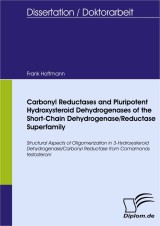Details

Carbonyl Reductases and Pluripotent Hydroxysteroid Dehydrogenases of the Short-Chain Dehydrogenase/Reductase Superfamily
Structural Aspects of Oligomerization in 3-Hydroxysteroid Dehydrogenase/Carbonyl Reductase from Comamonas testosteroni1. Auflage
|
58,00 € |
|
| Verlag: | diplom.de |
| Format: | |
| Veröffentl.: | 13.08.2009 |
| ISBN/EAN: | 9783836633918 |
| Sprache: | englisch |
| Anzahl Seiten: | 216 |
Dieses eBook erhalten Sie ohne Kopierschutz.
Beschreibungen
Inhaltsangabe:Introduction:
Metabolic reduction is the counterpart to oxidative pathways and plays an important role in the phase-I metabolism of carbonyl group bearing substances. Carbonyl reduction means the formation of a hydroxy group from a reactive aldehyde or ketone moiety and is generally regarded as an inactivation or detoxification step since the resulting alcohol is easier to conjugate and to eliminate. Not only are these carbonyl-containing compounds widespread in the environment and enter the body as xenobiotics and environmental pollutants, but they can also be generated endogenously through normal catabolic oxidation and deamination reactions. Many endogenous compounds such as biogenic amines, steroids, prostaglandins and other hormones are metabolized through carbonyl intermediates. In addition, lipid peroxidation within the cell results in the production of reactive carbonyls such as acrolein, 4-hydroxynonenal, 4-oxononenal and malon-dialdehyde, while oxidative damage to DNA generates base propenals. Dietary sources of carbonyl-containing compounds are diverse and include aldehydes found in fruits as well as the breakdown product of ethanol, acetaldehyde. Pharmacologic drugs represent further sources of exposure to carbonyl-containing compounds.
From the pharmacologist?s point of view, carbonyl reduction has been shown to be of significance in various inactivation processes of drugs bearing a carbonyl group. On the other hand, the carbinols formed may retain therapeutic potency, thus prolonging the pharmacodynamic effect of the parent drug, or, in some instances, a compound gains activity through carbonyl reduction.
From the toxicologist?s point of view, carbonyl reduction plays an important role in the toxification of drugs such as daunorubicin and doxorubicin (cf. chapter 4), whereas numerous reports corroborate the concept of carbonyl-reducing enzymes being involved in detoxification processes of endogenous and xenobiotic reactive carbonyl compounds.
Compared with the oxidative cytochrome P450 (CYP) system, carbonyl-reducing enzymes had, for a long time, received considerably less attention. However, the advancement of carbonyl reductase molecular biology has allowed the identification and characterization of several carbonyl-reducing enzymes, including pluripotent hydroxysteroid dehydrogenases that are involved in xenobiotic carbonyl compound metabolism, in addition to catalyzing the oxidoreduction of their physiologic […]
Metabolic reduction is the counterpart to oxidative pathways and plays an important role in the phase-I metabolism of carbonyl group bearing substances. Carbonyl reduction means the formation of a hydroxy group from a reactive aldehyde or ketone moiety and is generally regarded as an inactivation or detoxification step since the resulting alcohol is easier to conjugate and to eliminate. Not only are these carbonyl-containing compounds widespread in the environment and enter the body as xenobiotics and environmental pollutants, but they can also be generated endogenously through normal catabolic oxidation and deamination reactions. Many endogenous compounds such as biogenic amines, steroids, prostaglandins and other hormones are metabolized through carbonyl intermediates. In addition, lipid peroxidation within the cell results in the production of reactive carbonyls such as acrolein, 4-hydroxynonenal, 4-oxononenal and malon-dialdehyde, while oxidative damage to DNA generates base propenals. Dietary sources of carbonyl-containing compounds are diverse and include aldehydes found in fruits as well as the breakdown product of ethanol, acetaldehyde. Pharmacologic drugs represent further sources of exposure to carbonyl-containing compounds.
From the pharmacologist?s point of view, carbonyl reduction has been shown to be of significance in various inactivation processes of drugs bearing a carbonyl group. On the other hand, the carbinols formed may retain therapeutic potency, thus prolonging the pharmacodynamic effect of the parent drug, or, in some instances, a compound gains activity through carbonyl reduction.
From the toxicologist?s point of view, carbonyl reduction plays an important role in the toxification of drugs such as daunorubicin and doxorubicin (cf. chapter 4), whereas numerous reports corroborate the concept of carbonyl-reducing enzymes being involved in detoxification processes of endogenous and xenobiotic reactive carbonyl compounds.
Compared with the oxidative cytochrome P450 (CYP) system, carbonyl-reducing enzymes had, for a long time, received considerably less attention. However, the advancement of carbonyl reductase molecular biology has allowed the identification and characterization of several carbonyl-reducing enzymes, including pluripotent hydroxysteroid dehydrogenases that are involved in xenobiotic carbonyl compound metabolism, in addition to catalyzing the oxidoreduction of their physiologic […]
Inhaltsangabe:Introduction:
Metabolic reduction is the counterpart to oxidative pathways and plays an important role in the phase-I metabolism of carbonyl group bearing substances. Carbonyl reduction means the formation of a hydroxy group from a reactive aldehyde or ketone moiety and is generally regarded as an inactivation or detoxification ...
Metabolic reduction is the counterpart to oxidative pathways and plays an important role in the phase-I metabolism of carbonyl group bearing substances. Carbonyl reduction means the formation of a hydroxy group from a reactive aldehyde or ketone moiety and is generally regarded as an inactivation or detoxification ...

















